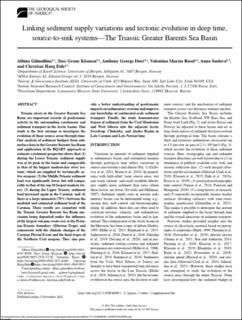Linking sediment supply variations and tectonic evolution in deep time, source-to-sink systems—The Triassic Greater Barents Sea Basin
Gilmullina, Albina; Klausen, Tore Grane; Doré, Anthony George; Rossi, Valentina Marzia; Suslova, Anna A.; Eide, Christian Haug
Journal article, Peer reviewed
Published version

Åpne
Permanent lenke
https://hdl.handle.net/11250/2831758Utgivelsesdato
2021Metadata
Vis full innførselSamlinger
- Department of Earth Science [1050]
- Registrations from Cristin [9791]
Sammendrag
Triassic strata in the Greater Barents Sea Basin are important records of geodynamic activity in the surrounding catchments and sediment transport in the Arctic basins. This study is the first attempt to investigate the evolution of these source areas through time. Our analysis of sediment budgets from subsurface data in the Greater Barents Sea Basin and application of the BQART approach to estimate catchment properties shows that (1) during the Lower Triassic, sediment supply was at its peak in the basin and comparable to that of the biggest modern-day river systems, which are supplied by tectonically active orogens; (2) the Middle Triassic sediment load was significantly lower but still comparable to that of the top 10 largest modern rivers; (3) during the Upper Triassic, sediment load increased again in the Carnian; and (4) there is a large mismatch (70%) between the modeled and estimated sediment load of the Carnian. These results are consistent with the Triassic Greater Barents Sea Basin succession being deposited under the influence of the largest volcanic event ever at the Permian-Triassic boundary (Siberian Traps) and concurrent with the climatic changes of the Carnian Pluvial Event and the final stages of the Northern Ural orogeny. They also provide a better understanding of geodynamic impacts on sedimentary systems and improve our knowledge of continental-scale sediment transport. Finally, the study demonstrates bypass of sediment from the Ural Mountains and West Siberia into the adjacent Arctic Sverdrup, Chukotka, and Alaska Basins in Late Carnian and Late Norian time.
